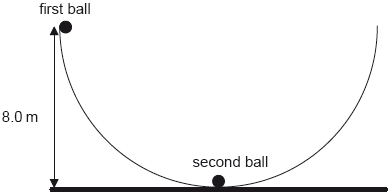| Date | May 2017 | Marks available | 3 | Reference code | 17M.2.SL.TZ2.1 |
| Level | Standard level | Paper | Paper 2 | Time zone | 2 |
| Command term | Determine | Question number | 1 | Adapted from | N/A |
Question
A glider is an aircraft with no engine. To be launched, a glider is uniformly accelerated from rest by a cable pulled by a motor that exerts a horizontal force on the glider throughout the launch.
The glider reaches its launch speed of 27.0 m s–1 after accelerating for 11.0 s. Assume that the glider moves horizontally until it leaves the ground. Calculate the total distance travelled by the glider before it leaves the ground.
The glider and pilot have a total mass of 492 kg. During the acceleration the glider is subject to an average resistive force of 160 N. Determine the average tension in the cable as the glider accelerates.
The cable is pulled by an electric motor. The motor has an overall efficiency of 23 %. Determine the average power input to the motor.
The cable is wound onto a cylinder of diameter 1.2 m. Calculate the angular velocity of the cylinder at the instant when the glider has a speed of 27 m s–1. Include an appropriate unit for your answer.
After takeoff the cable is released and the unpowered glider moves horizontally at constant speed. The wings of the glider provide a lift force. The diagram shows the lift force acting on the glider and the direction of motion of the glider.
Draw the forces acting on the glider to complete the free-body diagram. The dotted lines show the horizontal and vertical directions.
Explain, using appropriate laws of motion, how the forces acting on the glider maintain it in level flight.
At a particular instant in the flight the glider is losing 1.00 m of vertical height for every 6.00 m that it goes forward horizontally. At this instant, the horizontal speed of the glider is 12.5 m s–1. Calculate the velocity of the glider. Give your answer to an appropriate number of significant figures.
Markscheme
correct use of kinematic equation/equations
148.5 or 149 or 150 «m»
Substitution(s) must be correct.
a = or 2.45 «m s–2»
F – 160 = 492 × 2.45
1370 «N»
Could be seen in part (a).
Award [0] for solution that uses a = 9.81 m s–2
ALTERNATIVE 1
«work done to launch glider» = 1370 x 149 «= 204 kJ»
«work done by motor»
«power input to motor» or 80.4 or 81 k«W»
ALTERNATIVE 2
use of average speed 13.5 m s–1
«useful power output» = force x average speed «= 1370 x 13.5»
power input = «» 80 or 80.4 or 81 k«W»
ALTERNATIVE 3
work required from motor = KE + work done against friction «» = 204 «kJ»
«energy input»
power input k«W»
Award [2 max] for an answer of 160 k«W».
«»
rad s–1
Do not accept Hz.
Award [1 max] if unit is missing.
drag correctly labelled and in correct direction
weight correctly labelled and in correct direction AND no other incorrect force shown
Award [1 max] if forces do not touch the dot, but are otherwise OK.
name Newton's first law
vertical/all forces are in equilibrium/balanced/add to zero
OR
vertical component of lift mentioned
as equal to weight
any speed and any direction quoted together as the answer
quotes their answer(s) to 3 significant figures
speed = 12.7 m s–1 or direction = 9.46º or 0.165 rad «below the horizontal» or gradient of


